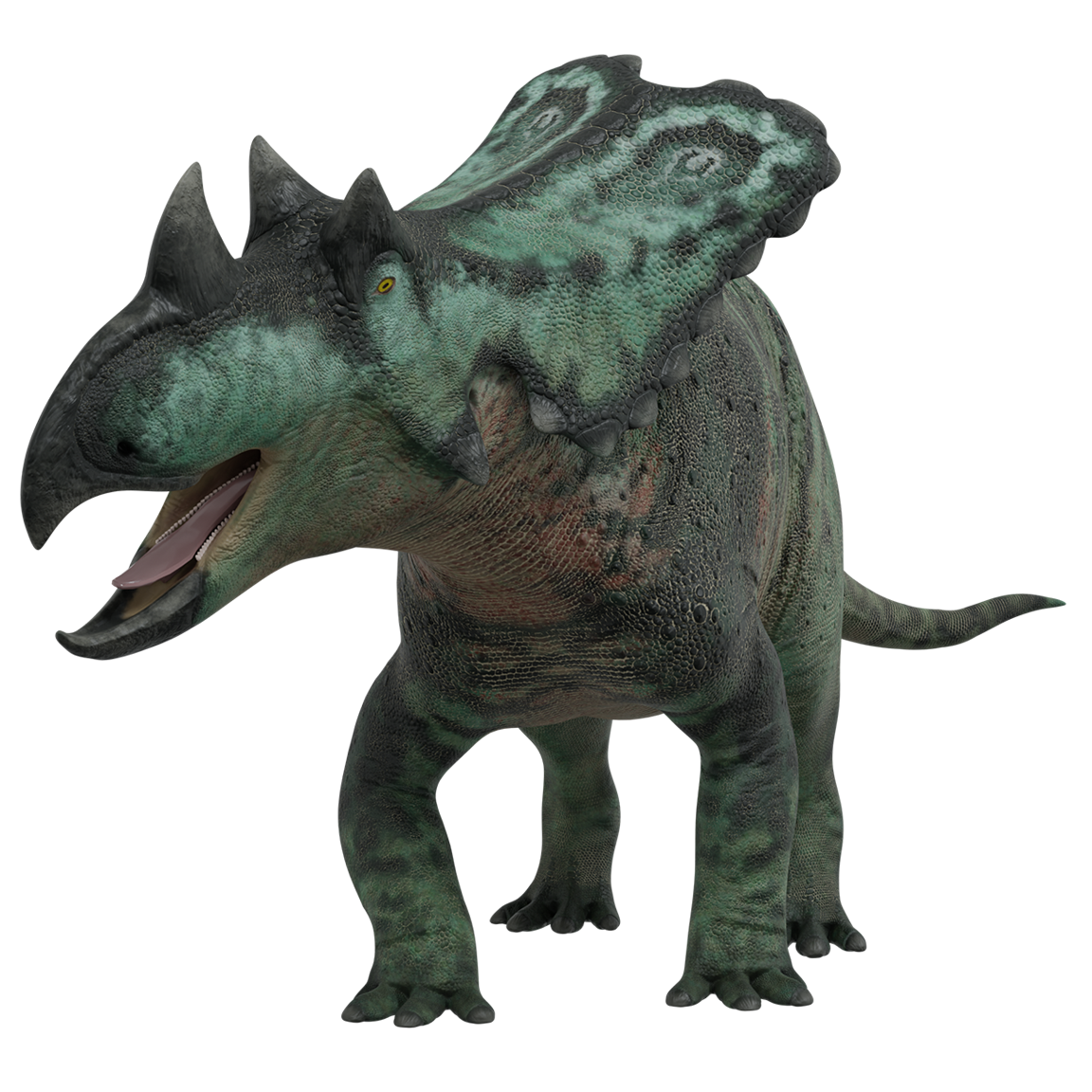The Chasm-Frilled Older Cousin of Triceratops
Ceratopsids like the large-frilled Chasmosaurus, an older relative of Triceratops, were among the most charismatic Late Cretaceous dinosaurs. Numerous quality specimens of this animal have been discovered making it one of the best known of all horned dinosaurs.
Overview: Ceratopsids, known for their showy frills and horns, are among the most charismatic of Late Cretaceous dinosaurs. One such charismatic creature was the medium-sized, but large-frilled Chasmosaurus, an older relative of Triceratops, discovered at the end of the 19th Century by Lawrence Morris Lambe in the Dinosaur Park Formation of Alberta, Canada. Numerous specimens of this dinosaur, including several skulls, a juvenile skeleton, and skin impressions have been discovered, making it one of the best known of all ceratopsians.
Discovery: Chasmosaurus belli was discovered in 1898 at Berry Creek, Alberta in the rocks of the Dinosaur Park Formation by Lawrence Morris Lambe who was working for the Canadian Geologic Survey (CGS). This original specimen was extremely incomplete, just part of the frill. Lambe named it as a new species of Monoclonius, Monoclonius belli, in honor of Walter Andrew Bell, a Canadian geologist and paleontologist also on the CGS. In 1913, Charles Hazelius Sternberg and sons discovered several complete skulls, which Lambe used in 1914, along with the original specimen, to erect a new genus, Protorosaurus. However, as this name was already taken by a different animal, he renamed his ceratopsid again, calling it Chasmosaurus, meaning “Opening Lizard” in Greek, from “khasma”, "opening" or "divide", and “sauros”, meaning “lizard”, named for the large holes in its frill. Since then, numerous additional specimens have been found, including a mostly complete juvenile skeleton and several skin impressions, making it one of the best known ceratopsids to date.
Evolution: Chasmosaurus was a member of the Ceratopsidae, large, quadrupedal, herbivorous, dinosaurs built like rhinos, with beaked jaws, horned faces, and frills extending from the back of their skulls over their necks. Ceratopsids can be split into two main groups, the Centrosaurinae, which generally had smaller frills and more prominent nose horns, and the Chasmosaurinae, which generally had larger frills and more prominent brow horns. Unsuprisingly, Chasmosaurus was a chasmosaurine. This makes it a close relative and possible ancestor of later forms like the famous Triceratops.
Description: Chasmosaurus was a medium sized ceratopsid, reaching lengths of 4.8 m (15.75 ft) and weighing about 2 tonnes (2.2 tons), about the size of a modern rhinoceros, to which it bore a superficial resemblance in overall body shape. It had a short horn on its nose, and a short brow horn over each eye. Its most distinctive feature was its large frill, which is elongated, somewhat rectangular in general outline (unlike the round frill of Triceratops) but also somewhat V-shaped, widening toward the back. The top of the frill was rounded, with a cleft in the middle, resembling the top of a heart shape. Two large fenestrae (holes) perforated the frill, which gave Chasmosaurus its name. In life, these fenestrae would have been covered in skin and may have been brightly colored. A three-year-old juvenile Chasmosaurus reveals that juveniles had similar body proportions to the adults, but smaller frills. Skin impressions from Chasmosaurus show that this animal had a rosette pattern of scales, with large scales spaced about every 10 cm surrounded by smaller scales.
Behavior and Ecology: Chasmosaurus lived 77-76 million years ago in a rich ecosystem in Late Cretaceous Alberta surrounded by a variety of other dinosaurs, including fellow ceratopsid Centrosaurus, the ornate hadrosaurs, Corythosaurus, Lambeosaurus, and Parasaurolophus, and the heavily armored ankylosaur Euoplocephalus. Chasmosaurus had a longer narrower snout than Centrosaurus, potentially implying niche partitioning between these genera, with Chasmosaurus being more selective of the plants it ate. The tyrannosaurs Daspletosaurus and Gorgosaurus were the apex predators of the region, and likely preyed upon Chasmosaurus. The horns and frills of Chasmosaurus may have helped deter or defend against these large predators. However, the frill, having the large fenestrae, therefore would have been a rather poor shield, and may have been used primarily for intimidation of these predators, and perhaps even more likely, showing off to other Chasmosaurus and intimidating rivals, much like the horns and antlers of many modern animals. Smaller predators of the Dinosaur Park Formation included troodontids and dromaeosaurs (“raptors”) like Dromaeosaurus. These would have posed little threat to an adult Chasmosaurus but may have hunted juveniles. But young Chasmosaurus wouldn’t have had to face them alone, as Chasmosaurus is thought to have had a high degree of parental care, like most modern herd animals. Juvenile Chasmosaurus likely stayed with their parents and would have been protected by the adults in the herd. When threatened, the ceratopsids may have formed a circle formation (horns and frills pointed outward) around their young similar to some modern animals like musk oxen.
Extinction and Legacy: Chasmosaurus wasn’t driven to extinction by any cataclysm. Rather it was simply replaced by new forms of ever diversifying chasmosaurine ceratopsians. Eventually, this lineage would produce the most famous horned dinosaur of all, Triceratops. Today, Chasmosaurus can be seen in many museums, perhaps most notably, the Canadian Museum of Nature in Ottawa, Ontario, Canada, the Royal Tyrell Museum in Drumheller, Alberta, Canada, the American Museum of Natural History in New York City, New York, USA, and the Royal Ontario Museum in Toronto, Ontario, Canada. Skulls of Chasmosaurus can be seen along with other ceratopsid skulls arranged into an evolutionary tree in both the Burpee Museum of Natural History in Rockford, Illinois, USA, and the Natural History Museum of Utah, in Salt Lake City, Utah, USA. Chasmosaurus was featured in the third episode of the 2011 BBC documentary series Planet Dinosaur.
Chasmosaurus FAQ
Chasmosaurus size / How big was Chasmosaurus?
See height, weight, and length.
Chasmosaurus height / How tall was Chasmosaurus?
Chasmosaurus was about 2.36 meters (7.74 ft) tall at the top of the frill.
Chasmosaurus weight / How much did Chasmosaurus weigh?
Chasmosaurus weighed about 2 tonnes (1.65 tons), similar to a modern rhinoceros.
How long was Chasmosaurus?
Chasmosaurus was about 4.8 m (15.75 ft) long!
What did Chasmosaurus eat?
Chasmosaurus ate low-growing plants, and its narrow snout may indicate that it was more selective about which plants, or parts of plants, it ate than Centrosaurus, another ceratopsid with which it shared its environment.
What is Chasmosaurus’s closest living relative?
Like all dinosaurs, the closest relatives of Chasmosaurus are the only surviving lineage of dinosaurs today, the birds. Crocodilians, while not dinosaurs themselves, are also more distant cousins of dinosaurs.
Chasmosaurus family members / Chasmosaurus family / What kind of dinosaur was Chasmosaurus?
Chasmosaurus was an ornithischian (“bird-hipped dinosaur”) in the family Ceratopsidae (horned and frilled dinosaurs) and the subfamily Chasmosaurinae making it a close relative of the later and larger Triceratops.
Where did Chasmosaurus live? / Where was Chasmosaurus found?
Chasmosaurus lived in Laramidia (western North America) and has been found in Alberta.
When did Chasmosaurus live?
Chasmosaurus lived about 77-76 million years ago in the Late Cretaceous Period.
What does Chasmosaurus mean? / Chasmosaurus name meaning
Chasmosaurus means “Opening Lizard” on account of the large openings in its frill.

